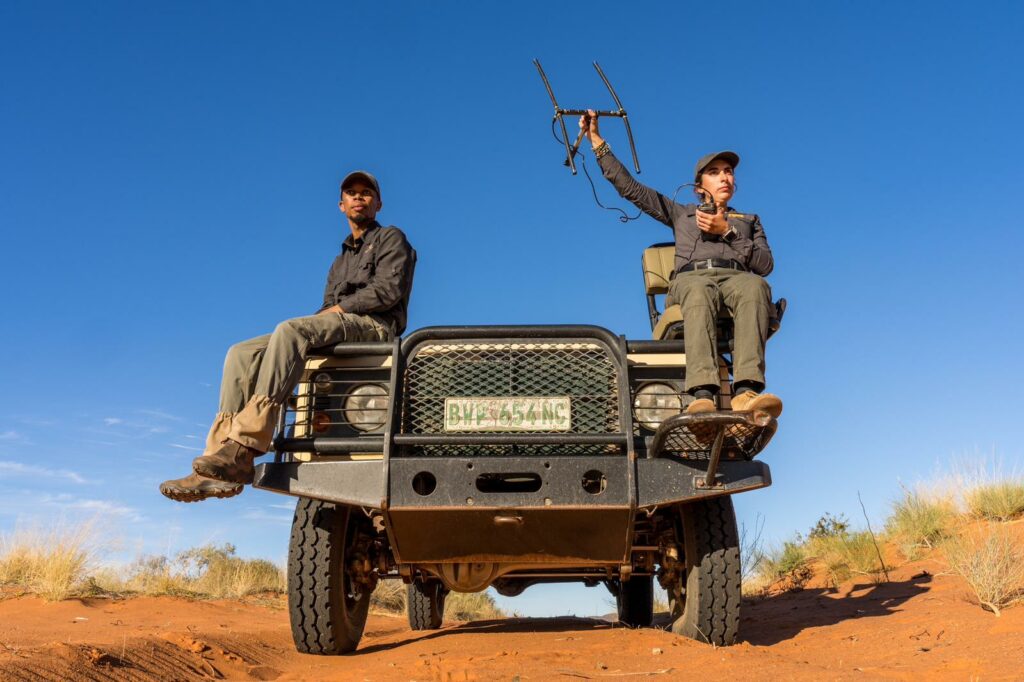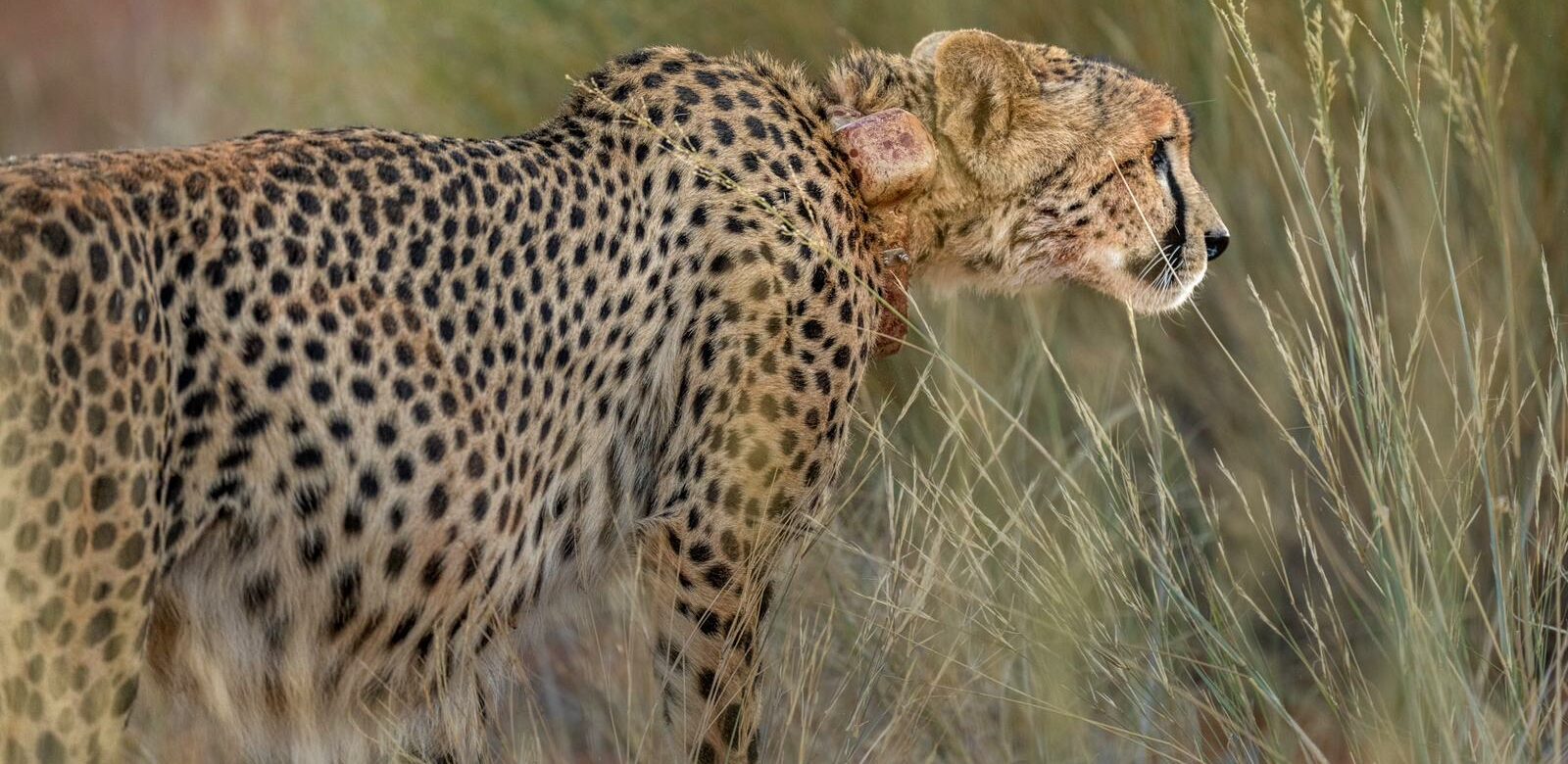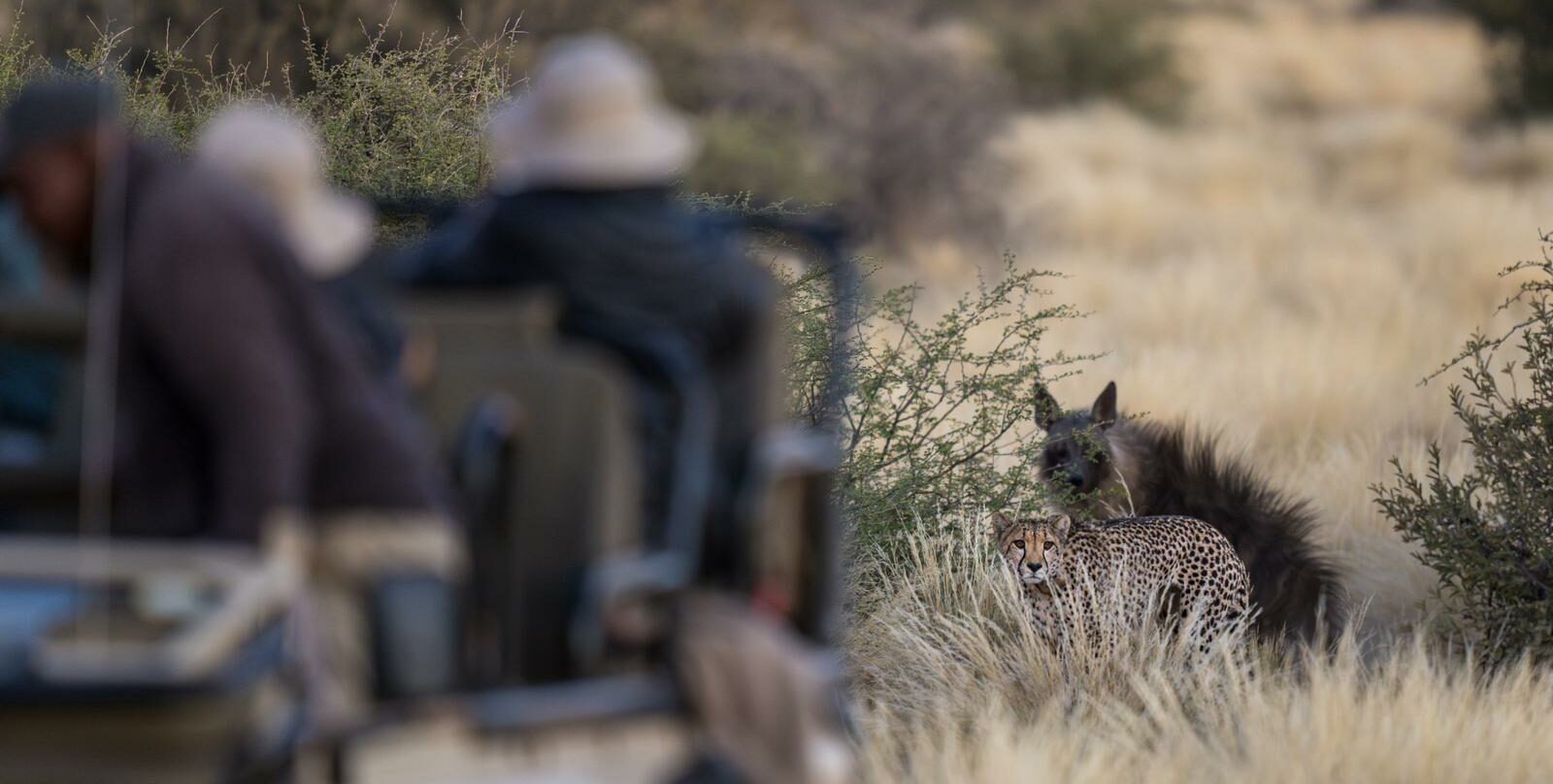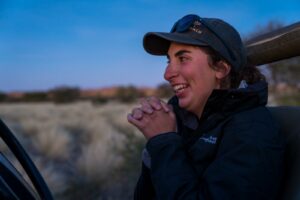UP CLOSE WITH A CHEETAH AND HER CUBS
Last year, on one of my visits to Tswalu, I spent a day with conservator Clement Motau, who was monitoring two collared cheetahs on the reserve. Back then, Clement predicted that the beautiful cheetah we had just spent a day with was a star in the making. If anything, that turned out to be an understatement. Currently raising four young cubs, the female cheetah simply known as “27” (after the last digits on her GPS collar) is now a full-blown superstar. But her relaxed behaviour around safari vehicles is no lucky coincidence.
The informal habituation of two collared cheetahs, which Clement began in mid-2022, has now become an official part of Tswalu’s conservation programme. In January of that year, former wildlife conservation student Micole Monteiro got involved full time with the habituation of cheetahs and meerkats. After spending a few days with Clement and Wendy Panaino, learning the basics of telemetry use and wildlife habituation, Micole’s days have consisted largely of ensuring that some of Tswalu’s most popular inhabitants remain relaxed around humans.

“I started with the meerkats,” Micole explains. “I would visit each of the three habituated groups every morning and see where they went foraging. That way, guides knew where to find them. If there were no guests, I often stayed with them for a bit longer. I also worked on finding a fourth group to habituate.”
A clear line is drawn between habituation and taming. There is no touching of the meerkats or allowing them to climb onto anyone. Through slow and regular habituation to Micole’s presence, the meerkats learn that human visitors aren’t a threat, and that they can carry on with their business without fear of being harmed or harassed.
HABITUATING CHEETAH TO STUDY THEIR BEHAVIOUR
Micole’s daily routine changed as cheetah habituation became more of a conservation priority. After leaving the meerkats each morning, Micole would try to locate one of the collared cats using her telemetry set.
 “I can get an idea of which area they are in using EarthRanger, but in the beginning it could still take hours to locate them with telemetry. They were very skittish and would often hide.”
“I can get an idea of which area they are in using EarthRanger, but in the beginning it could still take hours to locate them with telemetry. They were very skittish and would often hide.”
With time and patience, their behaviour changed. Micole found that she could get closer and closer, until the distance had shrunk to around ten metres.
“I tried to stop just before they ran away, but I wasn’t quiet. I left the radio on, talked to them, even played music. I wanted them to understand that vehicles and human voices didn’t represent a threat. After a while Clement and I started walking between them, too. Sometimes Tswalu’s trackers need to move around on foot, and we wanted the cheetahs to feel comfortable in those situations too.”
Habituating the cheetahs is done partly for the sake of human visitors, but primarily because it reduces the stress for the big cats when they see or hear vehicles. It also allows Micole to study their behaviour.
“Cheetahs are an endangered species, so it is important to monitor them and learn everything we can about their behaviour.”

CHEETAH 27’s EXCITING PLOT TWIST
A few months ago, the plot took another twist. Cheetah 27 was pregnant.
“We didn’t even realise she was pregnant until two weeks before she gave birth. It’s hard to tell sometimes. Their stomachs get big every time they eat, but hers stayed that way. That’s how we knew.”

Micole learned about the birth of the cubs the hard way.
“We went in on foot to check on her when she suddenly charged us. We caught a glimpse of the cubs – they were only a few days old – and realised why she needed space.”
Ten days later, Micole went back to check on the cubs. To her delight, 27 was her old, relaxed self again and did not react to the vehicle’s approach. A few weeks later, the sighting was made accessible to the guides and their guests, who have been respectfully visiting the cubs ever since. The colder temperatures in winter tend to keep the meerkats in their burrows until at least an hour after sunrise, so Micole has adapted her routine by checking in with the cheetahs first.

DON’T MESS WITH A MAMA CHEETAH
On my most recent trip to Tswalu, Micole, Clement and I headed for the dunes on a sunny winter afternoon. It did not take long for Micole to locate the five cheetahs – as is apparently so often the case, 27 was using the crest of a dune as a lookout. A few days earlier, I had watched an amusing stand-off between cheetahs and a Cape fox. It had ended with two of the cubs stalking and chasing off the fox, though the outcome might have been different had their mother not been nearby. This afternoon, the four young furballs crashed through the tall grass and attempted to climb camelthorn trees. How can anyone spend every day watching this and not fall in love?

“You can’t,” admitted Micole. “I have grown very attached to these cubs. But I have realized that it isn’t a bad thing, and many of the guides have told me that, too. It’s natural to care about them when you spend this much time together.”

After an hour or so, 27 decided it was time to find food. Leaving her cubs behind, she set off into the valley, moving with equal parts stealth and determination.
It was not to be. As the sun set, one of the cubs made a surprise appearance next to her, ruining any chances of hunting. Clearly resigned to this, she called for the other three – still several hundred metres away at the top of the dune – to join her as well.
Then, drama ensued. A brown hyena had heard 27 calling, too, and suddenly appeared from behind a bush. At nine weeks old, a cheetah cub would make a welcome meal. The distress 27 felt was obvious for everyone to see, especially as three of the cubs were still missing. Had the hyena already gotten to them?

What she lacked in size and weapons – a female cheetah’s jaws are not nearly as powerful as those of a brown hyena – she more than made up for in fierce determination. The hyena, clearly taken aback by 27’s ferocity, opted for an undignified retreat. As darkness fell, we watched the missing cubs tumble out of the vegetation and reunite with their mother. Aware that the hyena had not gone far, she decided to leave the area in search of a safer place to spend the night.
 Micole’s relief was palpable.
Micole’s relief was palpable.
“I didn’t want to watch; I was so stressed. I don’t know how she does it. One day it’s baboons, another it’s a hyena. Every day she’s fighting something. If we’d seen the hyena take one of the cubs, I would have cried. I can’t help it.”
Clement, too, was relieved that the cubs were safe, but also confident that Micole was the right person for this job.
“She’s really gotten out of her comfort zone and grown into this role. I’m very proud of her.”
All images by Marcus Westberg. Keep following @marcuswestbergphotography on instagram
